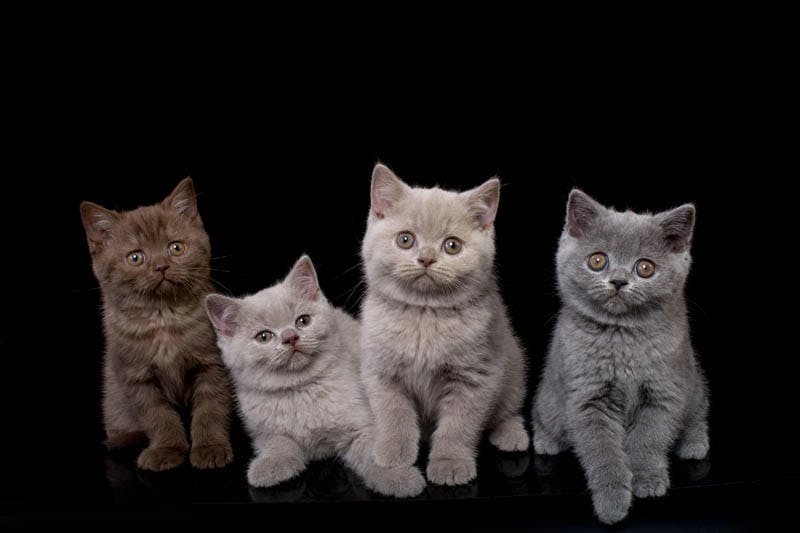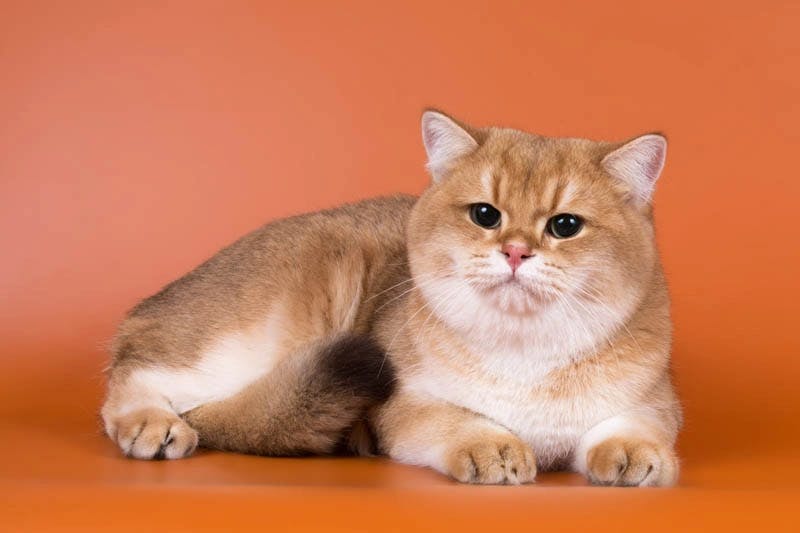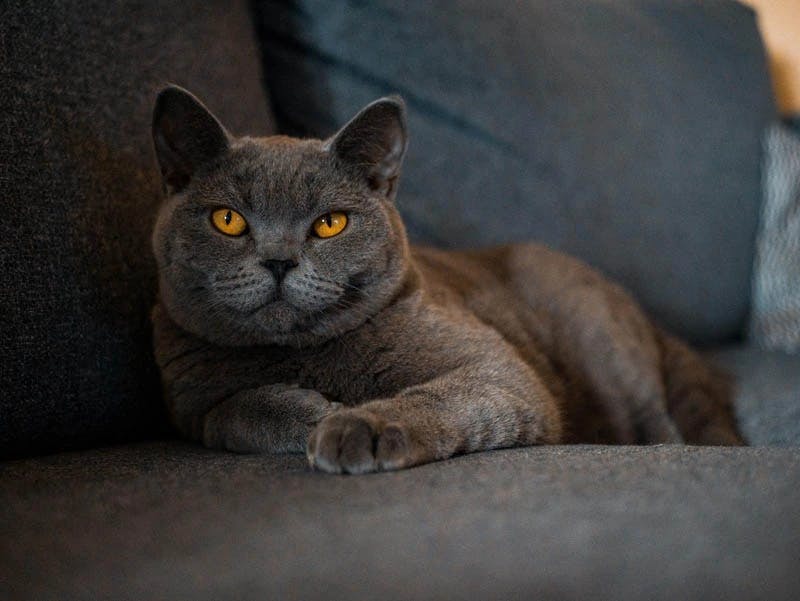British Shorthair
Cheshire Cat Befriends Kids and Pets Alike
British Shorthair
Anthonia Cirjak - Last Updated on December 18th, 2021
Things you Should Know about the British Shorthair
The British Shorthair is a big, solidly built cat with a magnificent fur color that matches its carefree personality.
There is also a longhaired variety of this breed. It doesn’t differ from the Shorthair in any other aspect other than the coat length.
A round head on a large roundish body, with big round eyes and paws, is what you see when looking at this smiling cat. It is the version of a British domestic cat that everyone knows and loves but with a pedigree.
The British Shorthair was also once called the British Blue. At the time, the blue-grey fur was the only recognized color for this breed. But this has changed over the years.
Now, this cartoonish looking furball comes in many beautiful colors and patterns.

Appearance Matters. What does a British Shorthair look like?
The British Shorthair is a large cat with a big, wide chest and relatively short legs. The tail isn’t long either, but it’s strong and thick with a blunt tip. Plump cheeks and an inviting, friendly expression make the shorthair very endearing.
Once you feel the fur of this cat under your fingers, you’ll understand why it’s one of the most popular cat breeds in general. The coat is incredibly soft and lavish, and despite it being extremely dense, it doesn’t shed as much as you’d think.
The British Shorthair kittens are rather slow to reach maturity. They reach their peak development at the age of three.
Interestingly, this breed has sexual dimorphism. This means that there are significant differences in adult sizes between female and male cats.
An adult male can reach up to 17, while the female typically doesn’t go over 12 pounds.
What colors do the British Shorthair cats come in?
The British Shorthair is mostly known for its fabulous ‘’blue’’ coat. But, there are many other stunning colors and patterns that are now included in the breed standard.
The most popular colors you’ll come across, aside from the iconic blue-grey, are the following:
- Black
- White
- Cinnamon
- Fawn
- Golden
- Cream
- Silver
- Red
- Orange
You’ll potentially also encounter lilac or chocolate variants, but the CFA standard doesn’t accept these colors.
It's all Personal. The British Shorthair Temperament
When it comes to the British Shorthair’s personality, it truly is the perfect companion.
These dignified cats will thoroughly enjoy your company but won’t relentlessly demand it as some other breeds might. Females tend to be a bit more standoffish, while males are more carefree.
Both sexes prefer to be in the presence of their family as opposed to mingling with strangers and visitors. They also do nicely in households with children and dogs that won’t chase them.
The British Blue isn’t a high-energy cat. They aren’t big fans of jumping or exerting themselves in general. You don’t have to worry about them leaping into the air to catch some dangly bit flying about.
They do appreciate a nice, low to the ground, interactive play session that ends with a not-too-long cuddle.
Are British Shorthair cats friendly?
Yes, these cats are very friendly. However, their friendliness isn’t what you’d normally expect. The British Shorthair doesn’t necessarily like a hands-on approach.
They would much rather exist calmly next to you, with an occasional pat on the head or a fur stroke.
Do British Shorthair cats get lonely?
Since they are bred with an independent streak, these cats are completely comfortable being on their own for a short while.
They won’t get lonely as they enjoy solitude. But, if you plan on being absent for longer than a few days, you should make sure someone is there to keep them company.
Do British Shorthair cats like to be held?
Unfortunately, if you’re looking for a cat that has a preference for sitting in laps and being held, this isn’t the breed for you.
They are patient with physical contact both with adults and children. But, some other cat breeds are better suited for an overly-affectionate owner.

Caring for your British Shorthair
The plush, short coat isn't difficult to groom. It does well with a weekly brushing to remove any debris and balance the skin.
During the shedding season in fall and spring, you will need to increase the frequency of brushing. Once a day is great to maintain the coat in great condition and avoid serious hair buildup in your home.
The longhair variety does tend to develop mats if left unbrushed for too long.
When it comes to other needed care, do check their ears regularly for any possible issues like redness or weird smell. Use a small cotton ball to clean the ears and maintain their health.
Do British Shorthairs shed a lot?
With dense fur like the one on a British Shorthair, you can expect a fair amount of shedding. This is particularly true during the shedding season.
However, this isn’t hard to control when compared to some other cat breeds if you maintain a regular brushing schedule.
Are British Shorthair cats hypoallergenic?
If you’re moderately or severely allergic to cat dander or saliva, the British Shorthair will not be the right choice for you.
Their hairs are short and able to get anywhere. This isn't good for a person that needs a cat with a minimal amount of allergens.
If your sensitivities are on the lower side, you might make it work with a lot of dedicated brushing sessions.
The Health and Happiness of your British Shorthair
The British Shorthair is a healthy breed with a lifespan of 10 to 12 years.
They do not generally suffer from many diseases.
But, they are prone to hemophilia B, which is a hereditary bleeding disorder. The disorder is traceable with a DNA test and should be done on any cat that is supposed to enter a breeding program.
Another possible health issue is hypertrophic cardiomyopathy (HCM). It causes thickening of the heart and can affect any cat of any breed.
Do note that HCM cannot be prevented and can only be confirmed in cats that are already ill. Stay away from breeders that guarantee that their cats will not be affected by this disease, as no one can predict this.
Should I let my British Shorthair outside?
If you decide to let your British Blue outside, make sure that the environment is secured and controlled. Being in nature doesn’t really come naturally for this breed, as their climbing or jumping skills aren’t necessarily the best.
If you decide against letting your cat outside, do make sure that they still get enough exercise to prevent weight issues.

Feline History. Where does the British Shorthair come from?
The British Shorthair is said to have arrived in Britain with the Roman invasion. During the Victorian Era, cat breeding became a trend.
The Shorthair was one of the very first breeds to emerge from this newly found passion.
During World War I, breeders added the Persian cat’s genes to create the British longhair, making a new variety of the nationally beloved cat.
After nearly becoming extinct during the Second World War, the breed enthusiasts brought it back. By crossing it with the Russian Blue, they gave it the distinctive blue coat we love today.
The British Shorthair was finally internationally recognized in 1967.
Questions people often ask about British Shorthair Kitten
+Are British Shorthairs friendly?
+Is the British Shorthair hypoallergenic?
+Can my British Shorthair be left alone?
+Where to Find the Best British Shorthair Breeders?
